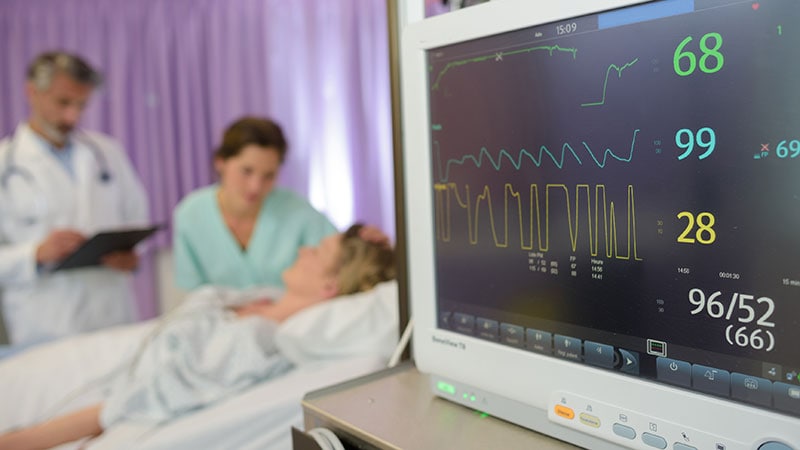The study covered in this summary was published on ResearchSquare.com as a preprint and has not yet been peer reviewed.
Key Takeaways
-
Patients with an acute myocardial infarction (MI) and a left ventricular ejection fraction (LVEF) < 50% and a systolic blood pressure (BP) of 90-99 mm Hg on admission have poor cardiovascular (CV) outcomes during their hospitalization; but outcomes were better for those with systolic BP ≥ 140mmHg.
-
Patients who have had an acute MI and have LVEF ≥ 50% and a systolic BP of ≥ 140 mm Hg on admission have poor long-term CV outcomes.
Why This Matters
Study Design
-
This was a retrospective study of 4114 adults with acute MI hospitalized at one center in Beijing between January 2013 and December 2019. The patients were followed after discharge until March 2020 (mean follow-up, 33 months).
-
The cohort included 812 patients with LVEF < 50% and 3302 with LVEF ≥ 50%. Both groups were further subdivided by admission systolic BP: 90-99 mmHg, 100-119 mmHg, 120-139 mmHg, and ≥ 140 mmHg.
-
The primary endpoint was CV death during hospitalization or after discharge. Secondary outcomes included major adverse cardiac and cerebral events (MACCE) including death from any cause, non-fatal MI, malignant arrhythmia, acute stent thrombosis, and stroke during the index hospitalization.
-
Endpoints were analyzed using logistic regression and Cox proportional hazard regression models.
Key Results
-
Patients with LVEF < 50% and systolic BP 90-99 mm Hg had a CV mortality of 14.3% and rate of MACCE at index hospitalization of 19.5%. These rates were significantly higher than in the other BP subgroups of the same LVEF group (P = .001).
-
In long-term follow-up, however, there were no significant differences in either CV mortality or MACCE among the BP subgroups of the < 50% group.
-
Among patients with LVEF ≥ 50%, there were no significant differences in hospitalization CV mortality or MACCE across the range of BP subgroups.
-
But in long-term follow-up of patients with LVEF ≥ 50%, those with systolic BP ≥ 140 mm Hg showed a CV death rate of 9.8% and all-cause mortality of 12.4%, significantly higher than for the other systolic BP subgroups (P = .012 and P = .006, respectively).
-
Patients with LVEF < 50% had significantly higher cardiogenic mortality both during hospitalization and long-term follow-up than the patients with LVEF ≥ 50% (P < .05).
-
The incidence of MACCE and CV death during hospitalization was significantly higher in patients with systolic BP < 120 mm Hg, particularly in the group with LVEF < 50%, suggesting that patients with acute MI with heart failure and systolic BP < 120 mm Hg have poor short-term outcomes.
-
The group with LVEF < 50% and systolic BP ≥ 140 mm Hg did not have significantly increased short-term or long-term CV outcomes. This may indicate that higher BP is needed to sustain coronary perfusion during the initial phase of acute MI in patients with heart failure.
Limitations
-
The retrospectively analysis of patients with acute MI at a single center may not apply to other populations.
-
Variables not accounted for in the analysis may confound and bias the results.
-
Follow-up time for CV events was short for some patients, which could affect the analyses.
-
Drug dosing and medication changes were not included, making it impossible to account for any intensification of therapy.
Disclosures
-
The authors report no conflicts of interest.
-
This study was supported by the National Key R&D Program of China and the National Natural Science Foundation of China.
This is a summary of a preprint research study, “Association between admission systolic blood pressure and cardiovascular events in acute myocardial infarction patients with different left ventricular ejection fraction,” written by Hui Qiu, Department of Cardiology, Beijing Friendship Hospital, Capital Medical University, and colleagues on Research Square, provided to you by Medscape. This study has not yet been peer reviewed. The full text of the study can be found on ResearchSquare.com.
For more from theheart.org | Medscape Cardiology, join us on Twitter and Facebook
Credits:
Lead Image: Auremar/Dreamstime
© 2022 WebMD, LLC
Send news tips to news@medscape.net.
Cite this: How Systolic BP Modulates LVEF Impact on Acute MI Outcomes - Medscape - Dec 29, 2022.
